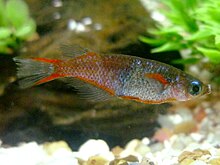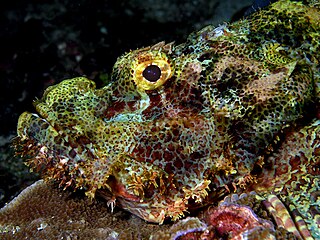
The Scorpaenidae are a family of mostly marine fish that includes many of the world's most venomous species. As their name suggests, scorpionfish have a type of "sting" in the form of sharp spines coated with venomous mucus. The family is a large one, with hundreds of members. They are widespread in tropical and temperate seas but mostly found in the Indo-Pacific. They should not be confused with the cabezones, of the genus Scorpaenichthys, which belong to a separate, though related, family, Cottidae.
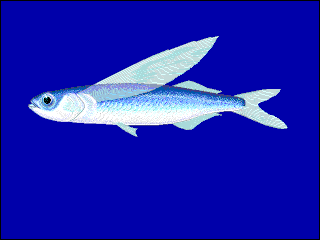
Beloniformes is an order composed of six families of freshwater and marine ray-finned fish:

The Japanese rice fish, also known as the medaka, is a member of genus Oryzias (ricefish), the only genus in the subfamily Oryziinae. This small native of Japan is a denizen of rice paddies, marshes, ponds, slow-moving streams and tide pools. It is euryhaline, occurring in both brackish and freshwater. It became popular as an aquarium fish because of its hardiness and pleasant coloration: its coloration varies from creamy-white to yellowish in the wild to white, creamy-yellow, or orange in aquarium-bred individuals. Bright yellow, red or green transgenic populations, similar to GloFish, have also been developed, but are banned from sale in the EU. The medaka has been a popular pet since the 17th century in Japan. After fertilization, the female carries her eggs attached anterior to the anal fin for a period before depositing them on plants or similar things.

Lake Poso is a lake in Central Sulawesi, Indonesia, and the third-deepest lake in Indonesia.
Oryzias celebensis, the Celebes medaka, fish in the family Adrianichthyidae. It is endemic to rivers, streams and lakes on the Indonesian island of Sulawesi and one river in East Timor.

Oryzias is a genus of ricefishes native to fresh and brackish water in east and south Asia. Some species are widespread and the Japanese rice fish is commonly used in science as a model organism, while others have very small ranges and are threatened. They are small, up to 8 cm (3.1 in) long, and most are relatively plain in colour.
Oryzias marmoratus, also known as the marmorated ricefish or marmorated medaka, is a species of fish in the family Adrianichthyidae, from Lake Towuti, Lake Mahalona, Lake Lontoa and associated streams in Sulawesi, Indonesia.
Oryzias matanensis, the Matano ricefish, is a species of fish in the family Adrianichthyidae. It is endemic to Lake Matano in Sulawesi, Indonesia.

The black buntingi is a species of fish in the family Adrianichthyidae. It is endemic to Lake Poso in Sulawesi, Indonesia, here it is a pelagic species found over sand and pebble substrates.
The sharp-jawed buntingi is a species of ricefish in the family Adrianichthyidae. It is endemic to Lake Poso in Sulawesi, Indonesia.
Oryzias profundicola, the yellow-finned medaka or yellow-finned ricefish, is a species of fish in the family Adrianichthyidae.
Popta's buntingi is a endangered species of fish in the family Adrianichthyidae. It is endemic to Lake Poso in Sulawesi, Indonesia. This species was described by Max Carl Wilhelm Weber and Lieven Ferdinand de Beaufort in 1922 and they gave it the species name poptae in honour of their fellow Dutch ichthyologist Canna Maria Louise Popta (1860-1929).

Oryzias sarasinorum, the Sarasins minnow or Sarasins buntingi, is a species of ricefish in the Adrianichthyidae. It is endemic to Lake Lindu in Lore Lindu National Park, Sulawesi, Indonesia. This species was described as Haplochilus sarasinorum by C.M.L. Popta in 1905 and she named it in honour of the Swiss naturalists and second cousins Paul Sarasin (1856-1929) and Fritz Sarasin (1859-1942), the latter being the collector of the type. Although the IUCN state that the population of this fish is stabled it is threatened by introduced non native fish, common carp, Mozambique tilapia and walking catfish; and a decline in water quality caused by increased agriculture in the lake's catchment which is causing a decline in water quality, it is therefore assessed as Critically Endangered.

Oryzias mekongensis is a species of fish in the family Adrianichthyidae. It is endemic to the Mekong River Basin in southeast Asia, where found in ditches, canals and ponds.
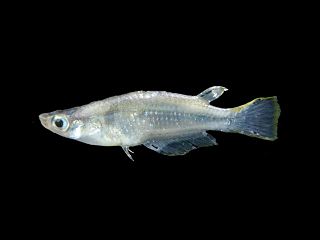
Oryzias javanicus, the Javanese ricefish, is a small species of fish in the family Adrianichthyidae. It lives in Peninsular Thailand, Malaysia, Singapore, and Indonesia, where it can be seen in both brackish and fresh water in ponds, ditches, mangrove, swamps, streams and canals.
Oryzias luzonensis is a species of fish in the family Adrianichthyidae. It is endemic to north Luzon in the Philippines, and it is difficult to keep in an aquarium. It is overall grayish with a yellow tinge above.
Oryzias curvinotus or the Hainan medaka is a species of ricefish which is found in Quang Ninh Province in northern Vietnam and Hainan, Guangdong and Hong Kong in southern China. It is found in both fresh and brackish water. This species was described as Aplocheilus curvinotus in 1927 by J.T. Nichols and C.H. Pope with the type locality given as Nodoa, Hainan Island, China.
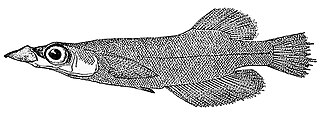
Adrianichthys is a genus of ricefishes. The genus is endemic to Lake Poso in Sulawesi, Indonesia. All four species are considered seriously threatened and two of these, A. kruyti and A. roseni, have not been recorded for decades, leading to fears that they already are extinct. Adrianichthys are larger than the Oryzias ricefish, reaching lengths of 8.5–17.1 cm (3.3–6.7 in) depending on the exact species involved. The name of this genus is a compound ending in the Greek ichthys for "fish" with the first part honouring the linguist and missionary Nicolaus Adriani (1865-1926), who collected specimens around Lake Poso.

The Chinese rice fish is a species of fish in the genus Oryzias. This freshwater fish occurs in swamps, stagnant parts of streams, rice fields and marshes, and is up to 3.1 cm (1.2 in) long. It was formerly considered a subspecies of the Japanese rice fish. The natural range of the Chinese rice fish is in East and Southeast Asia, including the Yangtze, Mekong, Irrawaddy, Salween, Red River and Nanpangjiang basins. It has been introduced to Kazakhstan and Russia ; also spreading in the Azov basin and has been discovered in the Obytichna River in Ukraine.
Adrianichthys roseni is a species of ricefish, a member of the family Adrianichthyidae which is endemic to Lake Poso on Sulawesi. Since the holotype was collected in 1978 there have been no reports of this species and if it still exists then it has a very low population. The IUCN categorise it as Critically Endangered.
